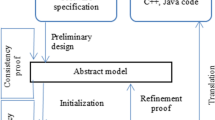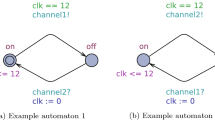Abstract
In this paper, a formal analysis of security protocols in the field of wireless sensor networks is presented. Three complementary protocols, TinySec, LEAP and TinyPK, are modelled using the high-level formal language HLPSL, and verified using the model checking tool AVISPA, where two main security properties are checked: authenticity and confidentiality of messages. As a result of this analysis, two attacks have been found: a man-in-the-middle-attack and a type flaw attack. In both cases confidentiality is compromised and an intruder may obtain confidential data from a node in the network. Two solutions to these attacks are proposed in the paper.
Similar content being viewed by others
References
Armando, A., Basin, D. A., Boichut, Y., Chevalier, Y., Compagna, L., Cuéllar, J., Drielsma, P. H., Héam, P. C., Kouchnarenko, O., Mantovani, J., Mödersheim, S., von Oheimb, D., Rusinowitch, M., Santiago, J., Turuani, M., Viganò, L., & Vigneron, L. (2005). The AVISPA tool for the automated validation of internet security protocols and applications. In K. Etessami & S. K. Rajamani (Eds.), Lecture notes in computer science : Vol. 3576. CAV (pp. 281–285). Berlin: Springer.
Backes, M., Mödersheim, S., Pfitzmann, B., & Viganò, L. (2006). Symbolic and cryptographic analysis of the secure WS-ReliableMessaging scenario. In L. Aceto & A. Ingólfsdóttir (Eds.), Lecture notes in computer science : Vol. 3921. FoSSaCS (pp. 428–445). Berlin: Springer.
Bellare, M., Desai, A., Jokipii, E., & Rogaway, P. (1997). A concrete security treatment of symmetric encryption. In Proceedings of 38th annual symposium on foundations of computer science (pp. 394–403). New York: IEEE.
Bellare, M., Kilian, J., & Rogaway, P. (2000). The security of the cipher block chaining message authentication code. Journal of Computer and Systems Sciences, 61(3), 362–399.
Bhargavan, K., Fournet, C., & Gordon, A. D. (2004). Verifying policy-based security for web services. In V. Atluri, B. Pfitzmann, & P. D. McDaniel (Eds.), ACM conference on computer and communications security (pp. 268–277). New York: Assoc. Comput. Mach.
Chan, H., Perrig, A., & Song, D. X. (2003). Random key predistribution schemes for sensor networks. In IEEE symposium on security and privacy (p. 197). Los Alamitos: IEEE Comput. Soc.
Chevalier, Y., Compagna, L., Cuéllar, J., Drielsma, P. H., Mantovani, J., Mödersheim, S., & Vigneron, L. (2004) A high level protocol specification language for industrial security-sensitive protocols. In Proceedings of workshop on specification and automated processing of security requirements (SAPS) (pp. 193–205).
Clarke, E. M., Grumberg, O., & Peled, D. A. (1999). Model checking. Cambridge: MIT Press.
Dolev, D., & Yao, A. C. C. (1981). On the security of public key protocols. In FOCS (pp. 350–357). New York: IEEE.
Eschenauer, L., & Gligor, V. (2002). A key-management scheme for distributed sensor networks. In V. Atluri (Ed.), ACM conference on computer and communications security (pp. 41–47). New York: Assoc. Comput. Mach.
Glouche, Y., Genet, T., Heen, O., & Courtay, O. (2006). A security protocol animator tool for AVISPA. In ARTIST2 workshop on security specification and verification of embedded systems, Pisa.
Heather, J., Lowe, G., & Schneider, S. (2003). How to prevent type flaw attacks on security protocols. Journal of Computer Security, 11(2), 217–244.
Hill, J., Szewczyk, R., Woo, A., Hollar, S., Culler, D. E., & Pister, K. S. J. (2000). System architecture directions for networked sensors. In Inter. conf. on architectural support for programming languages and operating systems, ASPLOS (pp. 93–104).
Karlof, C., Sastry, N., & Wagner, D. (2004). TinySec: a link layer security architecture for wireless sensor networks. In Proceedings of the 2nd international conference on embedded networked sensor systems, SenSys 2004 (pp. 162–175). Baltimore, MD, USA, November 3–5, 2004. New York: Assoc. Comput. Mach.
Lowe, G. (1998). Casper: A compiler for the analysis of security protocols. Journal of Computer Security, 6(1–2), 53–84.
Mitchell, J. C. (1998). Finite-state analysis of security protocols. In A. J. Hu & M. Y. Vardi (Eds.), Lecture notes in computer science : Vol. 1427. CAV (pp. 71–76). Berlin: Springer.
Perrig, A., Stankovic, J. A., & Wagner, D. (2004). Security in wireless sensor networks. Communications of the ACM, 47(6), 53–57.
Perrig, A., Szewczyk, R., Tygar, J. D., Wen, V., & Culler, D. E. (2002). SPINS: Security protocols for sensor networks. Wireless Networks, 8(5), 521–534.
Tobarra, M. L., Cazorla, D., Cuartero, F., & Diaz, G. (2005). Application of formal methods to the analysis of web services security. In M. Bravetti, L. Kloul, & G. Zavattaro (Eds.), Lecture notes in computer science : Vol. 3670. EPEW/WS-FM (pp. 215–229). Berlin: Springer.
Tobarra, M. L., Cazorla, D., Cuartero, F., & Diaz, G. (2006). Formal verification of TLS handshake and extensions for wireless networks. In Proc. of IADIS international conference on applied computing (AC’06) (pp. 57–64). San Sebastian: IADIS.
Watro, R., Kong, D., Cuti, S. F., Gardiner, C., Lynn, C., & Kruus, P. (2004). Tinypk: securing sensor networks with public key technology. In SASN’04: Proceedings of the 2nd ACM workshop on security of ad hoc and sensor networks (pp. 59–64). New York: Assoc. Comput. Mach. doi:10.1145/1029102.1029113, http://portal.acm.org/citation.cfm?id=1029113.
Zhu, S., Setia, S., & Jajodia, S. (2003). LEAP: efficient security mechanisms for large-scale distributed sensor networks. In S. Jajodia, V. Atluri, & T. Jaeger (Eds.), ACM conference on computer and communications security (pp. 62–72). New York: Assoc. Comput. Mach.
Author information
Authors and Affiliations
Corresponding author
Additional information
This work has been supported by the Spanish government with the project “Application of Formal Methods to Web Services”, with reference TIN2006-15578-C02-02, and the JCCM regional project “Application of formal methods to the design and analysis of Web Services and e-commerce” (PAC06-0008-6995).
Rights and permissions
About this article
Cite this article
Tobarra, L., Cazorla, D., Cuartero, F. et al. Model checking wireless sensor network security protocols: TinySec + LEAP + TinyPK. Telecommun Syst 40, 91–99 (2009). https://doi.org/10.1007/s11235-008-9131-z
Published:
Issue Date:
DOI: https://doi.org/10.1007/s11235-008-9131-z




